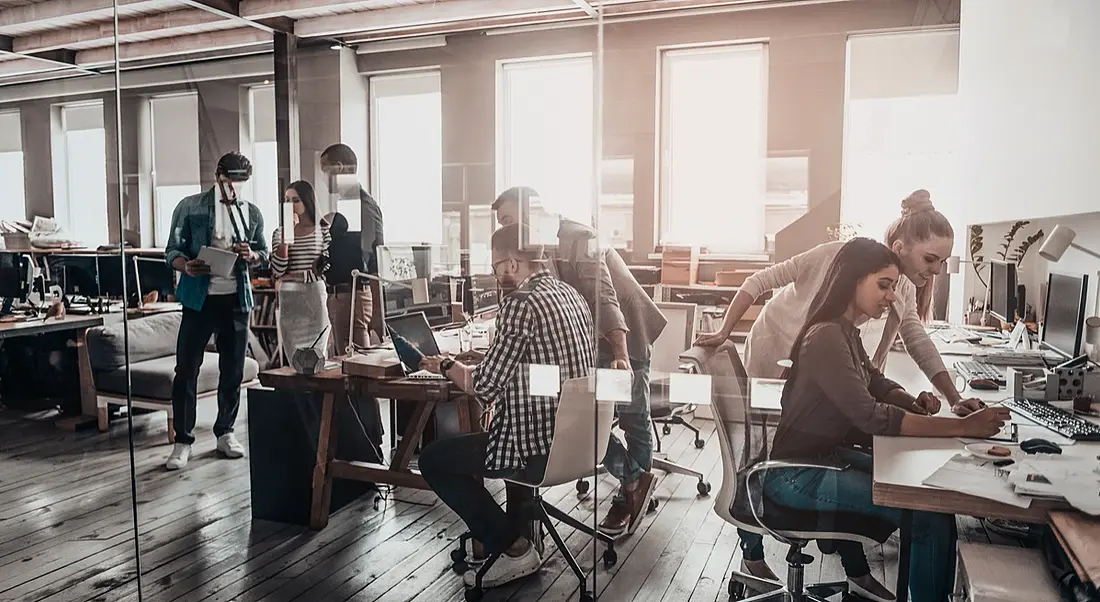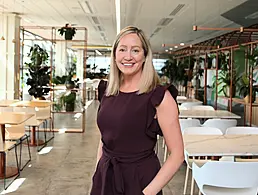Many are pondering the stability of their jobs and how AI will affect their day-to-day work. But what about the office in which you will work?
The future of work is full of new prospects and jobs that we’ve only begun to start finding our feet with.
When we think of the speed at which technology is developing, it’s no wonder that automation plays a big role in the future of work. The first thing we tend to think of when it comes to automation is jobs. Will our jobs still be there, or will they be replaced by robots?
But what about the space in which we work? What will the office of the future look like? Given that the future of work has already sort of arrived, it’s safe to say that several elements of our future office are already here, too.
The physical workspace
This is one of the most rigid and stable parts of the physical office building as we currently know it. Sure, the interiors might have been updated over the decades, more colour added, more things to encourage positive employee wellbeing, but the space has largely remained the same.
In more recent years, though, there’s been a gradual shift towards open-plan offices and more breakout areas to encourage better collaboration and a chance to unwind.
‘I think we need to be careful not to chase the perks’
– ELLYN SHOOK
Has the physical office reached the end of its revolution or will the future of work continue to transform the building in which we spend approximately 60pc of our time?
Ellyn Shook is Accenture’s chief leadership and human resources officer. She believes that the physical workspace must respond to its workers, the majority of which are coming from the millennial generation.
“Workplace and work environment design needs to align with what people value. So, the most important thing leaders can do is to listen to their people about what they need to be successful, including workplace. We risk going down the wrong path if we fail to seek their input and ideas,” she said.
“With respect to any workplace trends, I think we need to be careful not to chase the perks.”
While chasing perks for the sake of it would certainly be a bad idea when it comes to reinventing an office space, Accenture’s The Dock represents what technology and design can do to transform a space into the office of the future.
From power points hanging from the ceiling to movable screens, Accenture built an innovative workspace so that individuals and teams can design custom-built workspaces that best suit them.
“The building is filled with light, and natural materials are used throughout. The building is ‘smart’ with interactive digital screens throughout that respond to gestures and touch, while leveraging collaborative technology to work with colleagues around the globe,” said Shook.
The remote workspace
Remote working and the ‘gig economy’ will play a massive role in how the future-of-work office will transform.
Freelancers will soon make up 50pc of the global workforce, which means it’s unlikely for them to have a set desk in an office. Not only that, but people are increasingly favouring the ability to work from home or other locations. They might have a desk in the office building, but that is becoming less and less necessary.
So, where is the office really heading if fewer staff are actually going to be there?
“As work becomes more ‘borderless’, with collaboration happening across traditional organisational barriers, where work gets done will continue to change, too,” said Shook.
“Within our own organisation, our aspiration is that Accenture is the most truly human organisation in the digital age, where we are committed to helping our people be their best, both professionally and personally.”
Along with a vibrant start-up scene, the number of people who are working remotely has called for a huge surge in communal workspaces.
For example, Bank of Ireland launched its Workbenches in early 2015 to address the needs of those who needed a remote space to work. While it was start-ups the bank had in mind, the workspace is available for all who need it.
Meanwhile, Iconic Offices celebrated opening Ireland’s largest state-of-the-art shared workspace development earlier this year, with lightning-fast Wi-Fi and beer on tap.
The virtual workspace
“Digital is transforming the future of work across so many dimensions, including our definition of ‘workplace’, both physical and virtual,” said Shook.
Indeed, a virtual workplace is certainly becoming more of a reality in the ever-changing office, with AR and VR starting to play a role. For example, Fidelity Investments’ iLab in Dublin is already looking ahead to a world where VR headsets will become a normal part of working life.
Speaking to our editor John Kennedy earlier this year, the iLab’s tech team leader, Mike Quinn, said: “Implementation of this VR application in the real world is probably two to three years out, but to see it being used would be what success would look like to us.”
Holographic meetings might seem like a far-fetched concept best left to the sci-fi movies, but the truth is that VR technology is making virtual meetings very possible.
For example, AltspaceVR is a software start-up company that develops social software for VR environments. After a rocky summer, which saw the company almost come to an abrupt end, AltspaceVR was welcomed into the Microsoft family, so the future looks bright.
With apps such as these, VR-based meetings and headsets will become commonplace as workers continue to spread across the world.
The future of workspace collaboration
With freelancers and remote workers moving around, keeping different schedules, how will collaboration be affected in the future of work?
While those breakout areas and brainstorming spaces that we’ve become so familiar with won’t disappear completely, will there even be anyone in them to collaborate with?
Adrienne Gormley, global head of customer experience at Dropbox, spoke about this problem at Inspirefest earlier this year.
“There’s been a seismic shift in jobs over the past,” she said. “Less and less of the workforce are tied to an office.” Gormley said this trend is set to continue far beyond the next few years.
“Here’s my problem: while I get to enjoy working in the beautiful spaces in Dropbox Dublin, most of my team are scattered across the globe.”
Speaking about the music room in Dropbox, where employees get an opportunity to jam together, Gormley said: “I couldn’t jam with my team even if I wanted to. So, the challenge here is, how do we take these creative physical spaces and move them into the digital world?”
Shook said collaboration is an essential ingredient to spark creativity. “A work environment – physical space, virtual space and culture – that supports successful teaming is incredibly important,” she said.
“I also think we need to expand the definition of ‘who’ we collaborate with. We need to start thinking about how we collaborate across an entire ecosystem. We need to start thinking about things like collaborative robots, or ‘co-bots’, in our workspace.
“The future work environment must support all of these different connections.”




